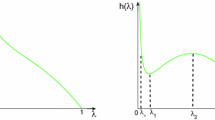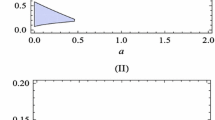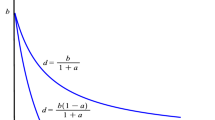Abstract
In this paper, we consider a diffusive predator–prey system with modified Holling–Tanner functional response under homogeneous Neumann boundary condition. The qualitative analysis and Hopf bifurcation of the original ODE system are discussed, the conditions of the Turing instability for the reaction–diffusion system are derived, and the Turing space in the parameters space is achieved. We present the results of numerical simulations in order to validate the obtained analytical findings. We found some interesting spatiotemporal patterns when parameter values are taken in Turing–Hopf domain, in which the dynamics shows spatiotemporal behavior that is influenced by temporal oscillations as well as by Turing instabilities. With the help of numerical simulations, we identified the different types of spatial patterns in this diffusive predator–prey system, including stationary spatial pattern, periodic competing dynamics, and spatiotemporal chaos.










Similar content being viewed by others
References
Holling, C.S.: The functional response of predator to prey density and its role in mimicry and population regulation. Mem. Entomol. Sec. Can. 45, 1–60 (1965)
Murray, J.D.: Mathematical Biology. Springer, Berlin (1989)
Banerjee, M., Banerjee, S.: Turing instabilities and spatio-temporal chaos in ratio-dependent Holling–Tanner model. Math. Biosci. 236, 64–76 (2012)
Skalski, G., Gilliam, J.F.: Functional responses with predator interference: viable alternatives to the Holling type II model. Ecology 82, 3083–3092 (2001)
Wollkind, J.D., Logan, J.A.: Temperature-dependent predator–prey mite ecosystem on apple tree foliage. J. Math. Biol. 6, 265–283 (1978)
May, R.M.: Stability and Complexity in Model Ecosystems. Princeton University Press, Princeton (1978)
Jeschke, J., Kopp, M., Tollrian, R.: Predator functional responses: discriminating between handling and digesting prey. Ecol. Monogr. 72, 95–112 (2002)
Hsu, S.B., Huang, T.W.: Global stability for a class of predator–prey systems. SIAM J. Appl. Math. 55, 763–783 (1995)
Shi, H.B., Li, W.T., Lin, G.: Positive steady states of a diffusive predator–prey system with modified Holling–Tanner functional response. Nonlinear Anal. Real Word Appl. 11, 3711–3721 (2010)
Beddington, J.R.: Mutual interference between parasites or predators and its effect on searching efficiency. J. Anim. Ecol. 44, 331–340 (1975)
DeAngelis, D.L., Goldstein, R.A., O’Neill, R.V.: A model for trophic interaction. Ecology 56, 881–892 (1975)
Turing, A.M.: The chemical basis of morphogenesis. Philos. Trans. R. Soc. Lond. Ser. B 237, 37–72 (1952)
Segel, L.A., Jackson, J.L.: Dissipative structure: an explanation and an ecological example. J. Theor. Biol. 37, 545–559 (1972)
Sherratt, J.A., Eagan, B.T., Lewis, M.A.: Oscillations and chaos behind predator–prey invasion: mathematical artifact or ecological reality? Philos. Trans. R. Soc. Lond. Ser. B 352, 21–38 (1997)
Li, M.F., Han, B., Xu, L., Zhang, G.: Spiral patterns near Turing instability in a discrete reaction diffusion system. Chaos, Solitons Fractals 49, 1–6 (2013)
Mukhopadhyay, B., Bhattacharyya, R.: Modeling the role of diffusion coefficients on Turing instability in a reaction–diffusion prey–predator system. Bull. Math. Biol. 68, 293–313 (2006)
Pascual, M.: Diffusion-induced chaos in a spatial predator–prey system. Philos. Trans. R. Soc. Lond. Ser. B 251, 1–7 (1993)
Sun, G.Q., Jin, Z., Zhao, Y.G., Liu, Q.X., Li, L.: Spatial pattern in a predator–prey system with both self- and cross-diffusion. Int. J. Mod. Phys. C 20, 71–84 (2009)
Sun, G.Q., Zhang, G., Jin, Z., Li, L.: Predator cannibalism can give rise to regular spatial pattern in a predator–prey system. Nonlinear Dyn. 58, 75–84 (2009)
McGehee, E.A., Peacock-López, E.: Turing patterns in a modified Lotka–Volterra model. Phys. Lett. A 342, 90–98 (2005)
Hoang, T., Hwang, H.J.: Turing instability in a general system. Nonlinear Anal. Theory Methods Appl. 91, 93–113 (2013)
Malchow, M.: Spatio-temporal pattern formation in nonlinear nonequilibrium plankton dynamics. Philos. Trans. R. Soc. Lond. Ser. B 251, 103–109 (1993)
Tian, C.R., Ling, Z., Lin, Z.G.: Turing pattern formation in a predator–prey-mutualist system. Nonlinear Anal. Real World Appl. 12, 3224–3237 (2011)
Wang, W.M., Liu, Q.X., Jin, Z.: Spatiotemporal complexity of a ratio-dependent predator–prey system. Phys. Rev. E 75, 051913 (2007)
Zhang, J.F., Li, W.T., Yan, X.P.: Hopf bifurcation and Turing instability in spatial homogeneous and inhomogeneous predator–prey models. Appl. Math. Comput. 218, 1883–1893 (2011)
Barrio, R.A., Varea, C., Arag\(\acute{o}\)n, J.L., Maini, P.K.: A two-dimensional numerical study of spatial pattern formation in interacting Turing systems. Bull. Math. Biol. 61, 483–505 (1999)
Nagorcka, B.N., Mooney, J.R.: From stripes to spots: prepatterns which can be produced in the skin by a reaction–diffusion system. IMA J. Math. Appl. Med. Biol. 9, 249–269 (1992)
Shoji, H., Iwasa, Y., Kondo, S.: Stripes, spots, or reversed spots in two-dimensional Turing systems. J. Theor. Biol. 224, 339–350 (2003)
Lou, Q., Chen, J.X., Zhao, Y.H., Shen, F.R., Fu, Y., Wang, L.L., Liu, Y.: Control of turbulence in heterogeneous excitable media. Phys. Rev. E 85, 026213 (2012)
Chen, J.X., Peng, L., Zhao, Y.H., You, S.P., Wu, N.J., Ying, H.P.: Dynamics of spiral waves driven by a rotating electric field. Commun. Nonlinear Sci. Numer. Simul. 19, 60–66 (2014)
Ma, J., Hu, B.L., Wang, C.N., Jin, W.Y.: Simulating the formation of spiral wave in the neuronal system. Nonlinear Dyn. 73, 73–83 (2013)
Hu, B.L., Ma, J., Tang, J.: Selection of multiarmed spiral waves in a regular network of neurons. PLoS One 8, e69251 (2013)
Zhang, T.H., Xing, Y.P., Zang, H., Han, M.A.: Spatio-temporal dynamics of a reaction–diffusion system for a predator–prey model with hyperbolic mortality. Nonlinear Dyn. 78, 265–277 (2014)
Wang, T.: Pattern dynamics of an epidemic model with nonlinear incidence rate. Nonlinear Dyn. 77, 31–40 (2014)
Zhao, H.Y., Huang, X.X., Zhang, X.B.: Turing instability and pattern formation of neural networks with reaction–diffusion terms. Nonlinear Dyn. 76, 115–124 (2014)
Liu, P.P., Xue, Y.: Spatiotemporal dynamics of a predator–prey model. Nonlinear Dyn. 69, 71–77 (2012)
Li, L., Jin, Z.: Pattern dynamics of a spatial predator–prey model with noise. Nonlinear Dyn. 67, 1737–1744 (2012)
Li, A.W.: Impact of noise on pattern formation in a predator–prey model. Nonlinear Dyn. 66, 689–694 (2011)
Sun, G.Q., Jin, Z., Li, L., Li, B.L.: Self-organized wave pattern in a predator–prey model. Nonlinear Dyn. 60, 265–275 (2010)
Wang, W.M., Zhang, L., Wang, H.L., Li, Z.Q.: Pattern formation of a predator–prey system with Ivlev-type functional response. Ecol. Model. 221, 131–140 (2010)
Baurmanna, M., Gross, T., Feudel, U.: Instabilities in spatially extended predator–prey systems: spatio-temporal patterns in the neighborhood of Turing–Hopf bifurcations. J. Theor. Biol. 245, 220–229 (2007)
Wakano, J.Y., Hauert, C.: Pattern formation and chaos in spatial ecological public goods games. J. Theor. Biol. 268, 30–38 (2011)
Garvie, M.R.: Finite-difference schemes for reaction–diffusion equations modeling predator–prey interactions in MATLAB. Bull. Math. Biol. 69, 931–956 (2007)
Nagano, S., Maeda, Y.: Phase transitions in predator–prey systems. Phys. Rev. E 85, 011915 (2012)
Hu, G.P., Li, X.L., Lu, S.P., Wang, Y.P.: Bifurcation analysis and spatiotemporal patterns in a diffusive predator–prey model. Int. J. Bifurc. Chaos 24, 1450081 (2014)
Dilão, R.: Turing instabilities and patterns near a Hopf bifurcation. Appl. Math. Comput. 164, 391–414 (2005)
Acknowledgments
The authors would like to thank the anonymous referees and the editors for their suggestions that greatly improved the presentation of this paper.
Author information
Authors and Affiliations
Corresponding author
Additional information
This work was supported by NNSF of China (No. 41375115).
Rights and permissions
About this article
Cite this article
Hu, G., Li, X. & Wang, Y. Pattern formation and spatiotemporal chaos in a reaction–diffusion predator–prey system. Nonlinear Dyn 81, 265–275 (2015). https://doi.org/10.1007/s11071-015-1988-2
Received:
Accepted:
Published:
Issue Date:
DOI: https://doi.org/10.1007/s11071-015-1988-2




